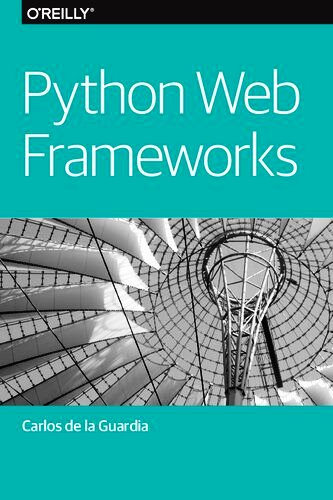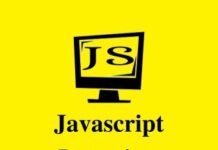| Book Name: | Python Web Frameworks |
| Category: | Computer Books ( CE & IT ) |
| Free Download: | Available |
Python Web Frameworks
Even though JavaScript tools dominate today’s web development landscape, Python provides aspiring web developers with a wide variety of useful web frameworks, written in a powerful, easy-to-learn language. This O’Reilly report surveys 30 Python web frameworks that have more than 1,000 monthly downloads and provides a deeper look into six of the most widely used.

Book Description
Despite the fact that JavaScript tools now rule the web development world, Python offers prospective web developers a large range of practical web frameworks that are developed in a strong, simple-to-learn language. This O’Reilly paper looks at 30 Python web frameworks that are used by more than 1,000 people every month and analyses six of the most popular ones.
Carlos de la Guardia, a seasoned Pythonist, explains a variety of Python web frameworks, from full-stack solutions with extensive capabilities to micro frameworks with an emphasis on simplicity and few features. You’ll learn what it takes to create your own framework, in addition to receiving advice on how to pick one that best suits your development requirements.
Explore the top six Python frameworks: Django, Flask, Tornado, Bottle, Pyramid, and CherryPy Explore the Python frameworks that are available, such as Appier, Cyclone, and Fantastico, as well as Grok, Muffin, and Twisted.
Look at the best way to use each of the top six, how to test it, code samples, and starting points.
Learn the basics of Python so you can build your own framework, and think about why you want to do that.
About the Author
Since 1994, Carlos De La Guardia has been working with Python, and since 2000, he has been developing for the web. He has contributed to several Plone projects of different sizes and has lately done more web development with Pyramid and Django. In addition to writing some open documentation for technologies like the ZODB, he is the author of the book Web Development with Grok.
Table of contents :
Introduction
What Do Web Frameworks Do?
Chapter 1. Python Web Framework Landscape
Web Framework List
Chapter 2. Some Frameworks to Keep an Eye On
Django
Quick Start
Representative Code
Automated Testing
When to Use Django
Flask
Quick Start
Representative Code
Automated Testing
When to Use Flask
Tornado
Quick Start
Representative Code
Automated Testing
When to Use Tornado
Bottle
Quick Start
Representative Code
Automated Testing
When to Use Bottle
Pyramid
Quick Start
Representative Code
Automated Testing
When to Use Pyramid
CherryPy
Quick Start
Representative Code
Automated Testing
When to Use CherryPy
Chapter 3. What’s the Right Framework for You?
Don’t Look for Absolute Bests
The “Best” Framework
The “Fastest” Framework
The “Smallest” Framework
Start by Defining Your Goals
Desirable Features
Documentation
Active Community
Reliability
Extensibility
Chapter 4. Developing Your Own Framework
Why Create a Framework?
Parts of a Basic WSGI Framework
Routing
Templates
Other Features
Documentation
Framework Building Blocks
WebOb (http://webob.org)
Werkzeug (http://werkzeug.pocoo.org)
Some Useful Resources
Chapter 5. Summary
Appendix A. Python Web Development Fundamentals
It’s All HTTP Underneath
Web Servers and WSGI
Installing Python Packages
Requirements for Installing Packages
Using pip
Virtual Environments
Python Web Frameworks PDF
Author(s): Carlos de la Guardia
Series: Free Web Development Ebooks
Publisher: O’Reilly Media, Year: 2016
ISBN: 9781491938102









![[PDF] Draw Buildings and Cities in 15 Minutes Draw Buildings and Cities in 15 Minutes pdf](https://www.freepdfbook.com/wp-content/uploads/2021/06/Draw-Buildings-and-Cities-in-15-Minutes-218x150.jpg)








![[PDF] Digital Image Processing An Algorithmic Introduction Using Java Digital Image Processing An Algorithmic Introduction Using Java](https://www.freepdfbook.com/wp-content/uploads/2022/06/Digital-Image-Processing-An-Algorithmic-Introduction-Using-Java.jpg)




![[PDF] 43 Years JEE ADVANCED + JEE MAIN Chapterwise & Topicwise Solved Papers 43 Years JEE ADVANCED (1978-2020) + JEE MAIN Chapterwise & Topicwise Solved Papers Physics PDF](https://www.freepdfbook.com/wp-content/uploads/2022/03/43-Years-JEE-ADVANCED-1978-2020.jpg)

![[PDF] Problems in Physical Chemistry for JEE (Main & Advanced) Problems in Physical Chemistry for JEE (Main & Advanced) Free PDF Book Download](https://www.freepdfbook.com/wp-content/uploads/2022/03/Problems-in-Physical-Chemistry-for-JEE-Main-Advanced.jpg)
![[PDF] Engineering Physics (McGraw Hill)](https://www.freepdfbook.com/wp-content/uploads/2021/05/bafc8c2685bb6823a9c56134f7fba5df.jpeg)

![[PDF] Engineering Chemistry By Shashi Chawla](https://www.freepdfbook.com/wp-content/uploads/2022/05/Theory-And-Practicals-of-Engineering-Chemistry-By-Shashi-Chawla-free-pdf-book.jpeg)
![[PDF] Chemistry: An Introduction to Organic, Inorganic & Physical Chemistry Chemistry: An Introduction to Organic, Inorganic & Physical Chemistry](https://www.freepdfbook.com/wp-content/uploads/2022/04/Chemistry-An-Introduction-to-Organic-Inorganic-Physical-Chemistry.jpg)
![[PDF] Essentials of Physical Chemistry Essentials of Physical Chemistry Free PDF Book by Bahl](https://www.freepdfbook.com/wp-content/uploads/2022/04/Essentials-of-Physical-Chemistry-bahl.jpg)
![[PDF] Biological control of plant-parasitic nematodes: soil ecosystem management in sustainable agriculture Biological control of plant-parasitic nematodes: soil ecosystem management in sustainable agriculture](https://www.freepdfbook.com/wp-content/uploads/2022/05/Biological-control-of-plant-parasitic-nematodes-soil-ecosystem-management-in-sustainable-agriculture.jpg)
![[PDF] Human Anatomy: Color Atlas and Textbook Human Anatomy: Color Atlas and Textbook Free PDF Book](https://www.freepdfbook.com/wp-content/uploads/2022/05/Human-Anatomy-Color-Atlas-and-Textbook.jpg)
![[PDF] Concepts of Biology Book [Free Download]](https://www.freepdfbook.com/wp-content/uploads/2022/05/Concepts-of-Biology.jpg)
![[PDF] Essentials of Biology [Free Download] Essentials of Biology Free PDF BOok Download](https://www.freepdfbook.com/wp-content/uploads/2022/05/Essentials-of-Biology-Free-PDF-Book-Downlaod.jpg)
![[PDF] Human Biology Book [Free Download]](https://www.freepdfbook.com/wp-content/uploads/2022/05/PDF-Human-Biology-Book-Free-Download.jpg)


